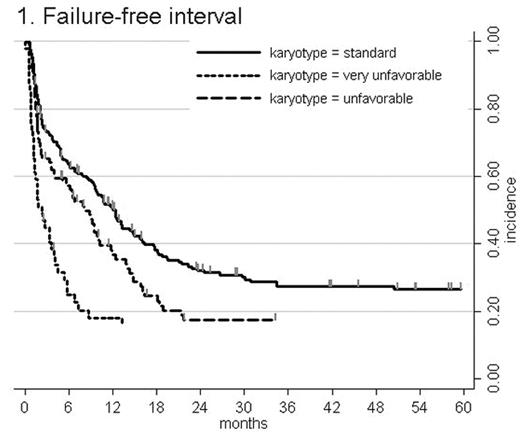Abstract
We have recently reported the superiority of prolonged ambulatory versus short intensive post-remission therapy in 416 patients with AML aged 65 years or more (median age, 72 years) selected to be treated intensively in the ALFA-9803 trial (C. Gardin et al. Blood 2007). We report here on the prognostic value of cytogenetic abnormalities in 339 of these patients with available karyotype (27 not done, 50 failures). When classical endpoints (CR rate, DFS, OS) were used, we were only able to identify one very unfavorable subgroup of 14% patients (N=49 with −7, abnormalities of both chromosomes 5 and 7, 3q abnormality, or complex karyotype with 5 abnormalities or more; CR rate, 30%). No significant differences in outcome were found between patients with any other abnormality and the 171 patients with a normal karyotype/−Y (overall CR rate, 62%). When cumulative incidences of AML-related events (primary refractory AML, relapses) were used as endpoints with induction deaths and deaths in first CR as competing events, three distinct subsets were more easily identified:
14% very unfavorable-risk patients, as detailed above;
59% standard-risk patients (N=200 with t(8;21), inv(16), normal karyotype/−Y, or isolated +8; CR rate, 65%); and
27% unfavorable-risk patients (N=90 with other abnormalities, including notably 5q− and 7q−; CR rate, 58%).
Median failure-free interval (Fig 1; P<.001, by the Gray test) and relapse-free interval (Fig 2; P<.001, by the Gray test) were 2.3, 12.4, and 8.1 months and 4.2, 15.0, and 10.5 months in these three subsets, respectively. Interestingly, prolonged ambulatory post-remission therapy was associated with longer DFS and OS in the standard-risk subset only. The results demonstrate that despite their poor general outcome, older patients with AML may be subdivided in three meaningful cytogenetic subgroups. This 3-subgroup classification should help to optimize disease management decisions such as intensive versus non-intensive or investigational therapies for induction or consolidation.
1. Failure-free interval
2. Relapse-free interval
Author notes
Disclosure: No relevant conflicts of interest to declare.



This feature is available to Subscribers Only
Sign In or Create an Account Close Modal